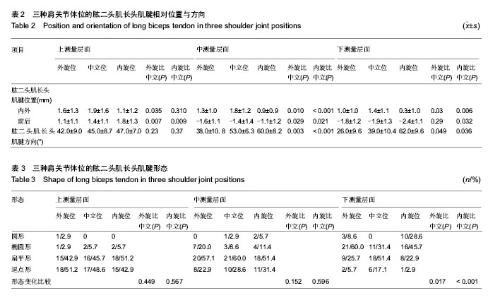| [1] Lafosse L, Reiland Y, Baier GP, et al. Anterior and posterior instability of the long head of the biceps tendon in rotator cuff tears: a new classification based on arthroscopic observations. Arthroscopy. 2007;23(1):73-80.
[2] Chan TW, Dalinka MK, Kneeland JB, et al. Biceps tendon dislocation: evaluation with MR imaging. Radiology. 1991; 179(3):649-652.
[3] Baumann B, Genning K, Böhm D, et al. Arthroscopic prevalence of pulley lesions in 1007 consecutive patients. J Shoulder Elbow Surg. 2008;17(1):14-20.
[4] Gaskin CM, Anderson MW, Choudhri A, et al. Focal partial tears of the long head of the biceps brachii tendon at the entrance to the bicipital groove: MR imaging findings, surgical correlation, and clinical significance. Skeletal Radiol. 2009 ; 38(10):959-965.
[5] Szymanski C, Staquet V, Deladerrière JY, et al. Reproducibility and reliability of subscapularis tendon assessment using CT-arthrography. Orthop Traumatol Surg Res. 2013;99(1):2-9.
[6] [6] Arai R, Sugaya H, Mochizuki T, et al. Subscapularis tendon tear: an anatomic and clinical investigation. Arthroscopy. 2008; 24(9):997-1004.
[7] Walch G, Nové-Josserand L, Boileau P, et al Subluxations and dislocations of the tendon of the long head of the biceps. J Shoulder Elbow Surg. 1998;7(2):100-108.
[8] Petersson CJ. Spontaneous medial dislocation of the tendon of the long biceps brachii. An anatomic study of prevalence and pathomechanics. Clin Orthop Relat Res. 1986;211: 224-227.
[9] Zappia M, Reginelli A, Russo A, et al. Long head of the biceps tendon and rotator interval. Musculoskelet Surg. 2013;97 Suppl 2:S99-108.
[10] Walz DM, Miller TT, Chen S, et al. MR imaging of delamination tears of the rotator cuff tendons. Skeletal Radiol. 2007;36(5):411-416.
[11] Schaeffeler C, Waldt S, Holzapfel K, et al. Lesions of the biceps pulley: diagnostic accuracy of MR arthrography of the shoulder and evaluation of previously described and new diagnostic signs. Radiology. 2012;264(2):504-513.
[12] De Maeseneer M, Boulet C, Pouliart N, et al. Assessment of the long head of the biceps tendon of the shoulder with 3T magnetic resonance arthrography and CT arthrography. Eur J Radiol. 2012;81(5):934-939.
[13] Spritzer CE, Collins AJ, Cooperman A, et al. Assessment of instability of the long head of the biceps tendon by MRI. Skeletal Radiol. 2001;30(4):199-207.
[14] Slätis P, Aalto K. Medial dislocation of the tendon of the long head of the biceps brachii. Acta Orthop Scand. 1979;50(1): 73-77.
[15] Hunt SA, Kwon YW, Zuckerman JD. The rotator interval: anatomy, pathology, and strategies for treatment. J Am Acad Orthop Surg. 2007;15(4):218-227.
[16] Arai R, Mochizuki T, Yamaguchi K, et al. Functional anatomy of the superior glenohumeral and coracohumeral ligaments and the subscapularis tendon in view of stabilization of the long head of the biceps tendon. J Shoulder Elbow Surg. 2010;19(1):58-64. |

